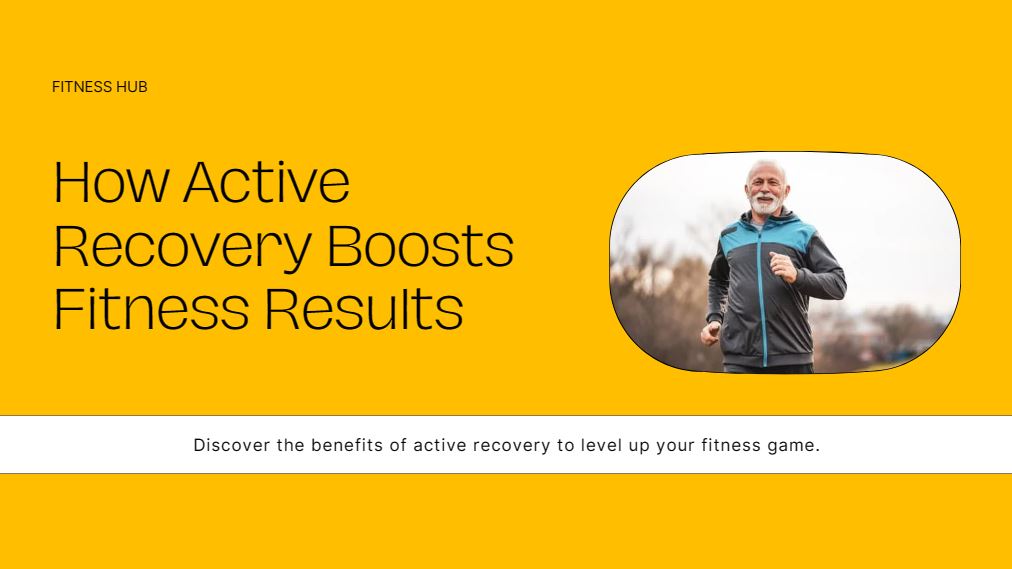If you’re hitting the gym relentlessly, shedding sweat and calories but not seeing the fitness results you want, it may be time for a change in approach. Before your mind darts to tougher routines or stricter diets, allow us to introduce you to the game changer: Active Recovery. Not only does active recovery act as a lifeline for tired muscles, but it serves as a secret catapult, thrusting you towards your fitness goals faster than ever before. Together we will uncover why this underutilized strategy is the missing piece in your workout regime and how incorporating it can supercharge your overall fitness results. Welcome aboard your journey to newfound strength, stamina, and speed with an unexpected ally – Rest!
Active recovery, through engaging in low-intensity exercises and activities on days following intense workouts, can aid the body’s natural repair processes, accelerate recovery, reduce muscle soreness, minimize the risk of injury, and improve overall fitness. By incorporating active recovery into your routine, you provide your muscles with gentle movement and promote blood flow without overtaxing them, leading to improved well-being and long-term fitness gains.

Understanding Active Recovery
Active recovery refers to low-intensity workouts or exercise that one engages in after high-intensity sessions. It is an essential aspect of workout routines or sports activities that help reduce muscle tension, soreness and speed up the repair process by improving blood flow to damaged tissues. Low-impact exercises such as walking, yoga, swimming, and cycling are some examples of active recovery.
For instance, if a person frequently does intense weightlifting, they may deduce active recovery by performing low-intensity bodyweight exercises on rest days.
The Science Behind Active Recovery
Incorporating active recovery into your fitness routine provides numerous benefits backed by science. Experts suggest that Active recovery helps in combating delayed onset muscle soreness (DOMS), which is caused due to tiny tears in muscle fibers post-workout. When one engages in lower intensity workouts, it helps reduce lactic acid buildup in the muscles and accelerates the removal of waste products built up during an intense workout session.
Some experts argue that complete rest days with no activity are far more beneficial for muscle repair than actively engaging in recovery. However, others suggest that low-intensity activities improve blood flow and promote healing.
Additionally, staying active even on rest days can aid in clearing out cortisol levels in the body – a hormone that contributes to stress often accumulated through rigorous workout sessions. Regular active recovery also positively impacts mental wellbeing and significantly reduces stress levels while promoting relaxation.
Having explored the science behind active recovery let’s look at the many benefits it has to offer.
Benefits of Active Recovery
Recovery is an essential, often overlooked aspect of fitness that underpins progress and sustainability in any workout regime. While rest days are crucial, active recovery provides a means to supplement recovery through light exercise to help alleviate muscle soreness, reduce stiffness, mitigate the risk of injury, and improve overall well-being. It offers a much-needed mental break from intense workouts while still keeping one active.
| Benefits of Active Recovery: |
|---|
| Alleviates muscle soreness |
| Reduces stiffness |
| Prevents injury |
| Provides a mental break |
| Encourages consistency |
| Improves overall wellness |
- Active recovery is an important part of any fitness routine as it helps alleviate muscle soreness, reduce stiffness, prevent injury, provide a mental break, encourage consistency, and improve overall wellness. It is often overlooked but crucial for sustainable progress in fitness.

The Role in Enhanced Performance
Active recovery plays an essential role in enhancing performance as it helps the body return to its baseline state over time. By engaging in low-intensity activity during recovery periods, circulation improves, promoting efficient nutrient distribution and clearing metabolic waste buildup. This process leads to faster muscle repair and regeneration, resulting in improved fitness results.
Different active recovery workouts target different parts of the body, giving them ample time to recover from high-intensity sessions while still being active. For example, stretching exercises can lead to increased flexibility and range of motion and lower the risk of strain or injury during workouts. Cardio-based activities such as cycling or swimming can improve aerobic capacity other than aiding in removing lactic acid waste built up after workouts.
Suppose you are training for a half marathon; after several intense training days where your primary focus has been leg work. Engaging lightly in yoga stretches or swimming aids in refreshing your body by engaging other muscles and allowing your leg muscles to rebuild while still keeping yourself active.
| Benefits of Active Recovery on Performance: |
|---|
| Efficient nutrient distribution |
| Faster muscle repair and regeneration |
| Improved flexibility and range of motion |
| Lowers the risk of strain or injury |
| Improves aerobic capacity during recovery |
Active Recovery Exercises and Their Impact
Active recovery exercises can have a profound impact on the body’s ability to recover from intense workouts and facilitate fitness gains. By engaging in low-impact physical activity, the body’s natural repair processes are activated, helping to accelerate post-workout recovery, reduce muscle soreness, minimize injury risk, and improve overall fitness. Rather than lazing around on rest days, incorporate active recovery into your routine to enhance the effects of your workout plan.
Think of it like a well-oiled machine; by adding fuel in the form of active recovery exercises, you’re ensuring that the machine operates smoothly and maintains peak condition.
Choosing the Best Activities
Selecting suitable activities for active recovery can be challenging, especially if you’re unsure which ones will be most effective. It’s essential to choose low-intensity exercises that keep your heart rate between 30 and 60% of its maximum capacity without exhausting or overworking your muscles. Walking, hiking, swimming, cycling, yoga or stretching can be optimal options as they contribute to aerobic conditioning without straining the muscles.
For instance, those who use running as their primary exercise form could use alternate time periods walking and jogging within reach other day while using a foam roller to target any sore areas after intense interval training.
It’s best to consider personal experience and preference when tailoring an active recovery regimen designed for forwarding progress toward fitness goals – The least popular form of light exercise is still better than not moving at all.
If you’re doing high-intensity workouts more than four times a week, incorporating one or two active recovery days is ideal for replenishing your body’s energy stores. Those working out moderately 3-5 times a week could aim for just one active recovery day per week. Moreover, starting with light active recovery activities on rest days can still be beneficial for beginners who work out only 1-2 times a week.
Listening to your body’s feedback is crucial when selecting appropriate activities. These exercises should feel relatively easy and refreshing rather than challenging or strenuous. If you feel ill or experience sharp pain from an injury, it’s best to take a rest day instead of an active recovery day.
Now that we have understood the importance of choosing suitable activities for active recovery regimens let’s move on to explore sample recovery regimens.
Sample Active Recovery Regimens
The beauty of active recovery is that it can be customized to fit individual needs. It’s essential to choose low-intensity exercises that improve blood flow and aid muscle repair without straining the body. Here are some sample active recovery regimens worth considering:
- Yoga and stretching: High stretching exercises relieve muscle tension by lengthening your muscles, reducing soreness, and aiding in recovery.
- Walking/hiking: A common active recovery regimen, walking/hiking are low-intensity forms of exercise that promote cardiovascular health and increased blood flow to muscles.
- Swimming and water aerobics: The buoyancy provided by water reduces stress on the joints while promoting endurance, strength building, and flexibility.
- Cycling: Instead of a high-intensity cycling routine, try a leisurely ride one or two days following a vigorous workout. This helps reduce stiffness and soreness in the legs by promoting increased circulation through the muscles.
These workouts can be customized to fit one’s schedule and preference best but always remember: the activity should provide sufficient rest with low strain on your body for maximum effectiveness.
Creating Your Active Recovery Schedule
Incorporating active recovery into your fitness routine requires creating an effective schedule. Without it, we might experience burnout or overexertion resulting in injury that takes us off training for weeks/three months or longer.
For instance, if you’re engaging high-intensity workouts more than four times a week, consider incorporating at least one or two days of active recovery in your fitness routine. In contrast, if you only work out moderately three to five times a week, keep one day for active recovery.
Light activities like walking or performing light stretches on our off-days may still promote adequate blood circulation necessary for muscle development even when starting to work out only 1-2 days per week.
The key is to take a thoughtful approach to avoid overtraining, which might lead to muscle strain and injuries. Active recovery days should be designed to refresh and rejuvenate the body, and they should not be as strenuous as workout days. If one feels sick or experiences sharp pain during an activity, rest the body rather than attempting active recovery.
Active recovery works like a regenerative sleep cycle – a time for the body to rest & heal while inviting new movements and blood flow in preparation for your next work out day.
Balancing Active Recovery with Rest Periods
When it comes to reaping the benefits of active recovery, it’s crucial to balance it with appropriate rest periods. While it might be tempting to prioritize active recovery over rest completely, that could lead to burnout or even injuries in the long run.
Rest periods are essential for allowing muscles, tendons, and bones to heal and recover from exertion. The body responds differently to physical activities than it does to complete rest, so incorporating both elements into your fitness routine is key. While you might feel guilty about taking a day off from working out altogether, remember that active rest can serve as an excellent compromise.
For instance, consider incorporating yoga sessions or stretching routines into your workout plan instead of high-intensity exercises every day. These low-impact activities can help maintain activity levels while giving your body the chance to recuperate fully.
However, it’s vital to find a balance between ample rest and active recovery since too much of either could hinder athletic objectives rather than bolster them. It would help if you listened to your body to decide how often you should schedule rest days or practice light physical activities.
Think of balancing active recovery with proper rest like investing money; placing all your funds in one stock may pay off initially but poses a significant risk in the long run. Whereas diversifying investments on different stocks will give higher returns and reduce potential losses.
It’s best to experiment with different schedules and observe how your body reacts. Typically, if engaging in high-intensity workouts more than four times a week, incorporating one or two active recovery days per week would be beneficial. If working out moderately three to five times a week, perhaps one active recovery day per week might suffice.
Below are some tips for choosing between active rest and complete rest:
| Active Recovery | Rest |
|---|---|
| Low-intensity workouts | Complete rest |
| Stretching | Mindful breathing/meditation |
| Yoga | Adequate sleep |
| Walking or hiking | Gentle massaging of sore muscles |
Ultimately, a well-rounded approach to fitness should recognize that the body needs appropriate and sufficient rest periods alongside active recovery workouts. When balanced correctly, active recovery can accelerate muscle repair and growth, prevent injury, help develop a positive attitude towards fitness in general, and lock-in consistent exercise habits.

James is the resident expert on fitness and move to earn. He’s been involved with Dustland Runner as a community manager since the beginning.